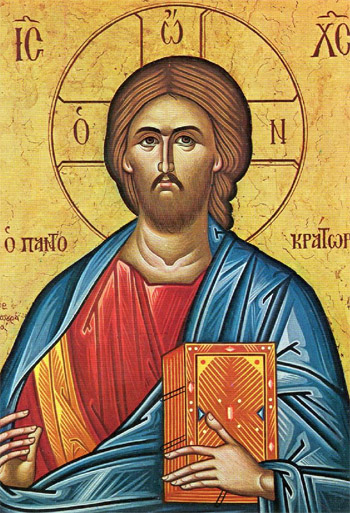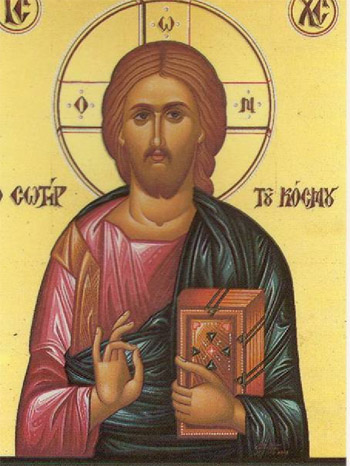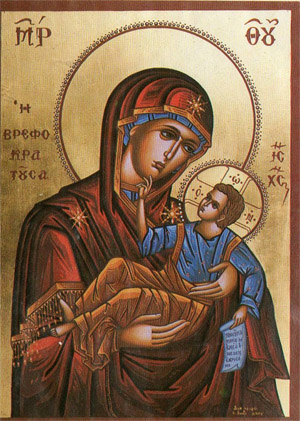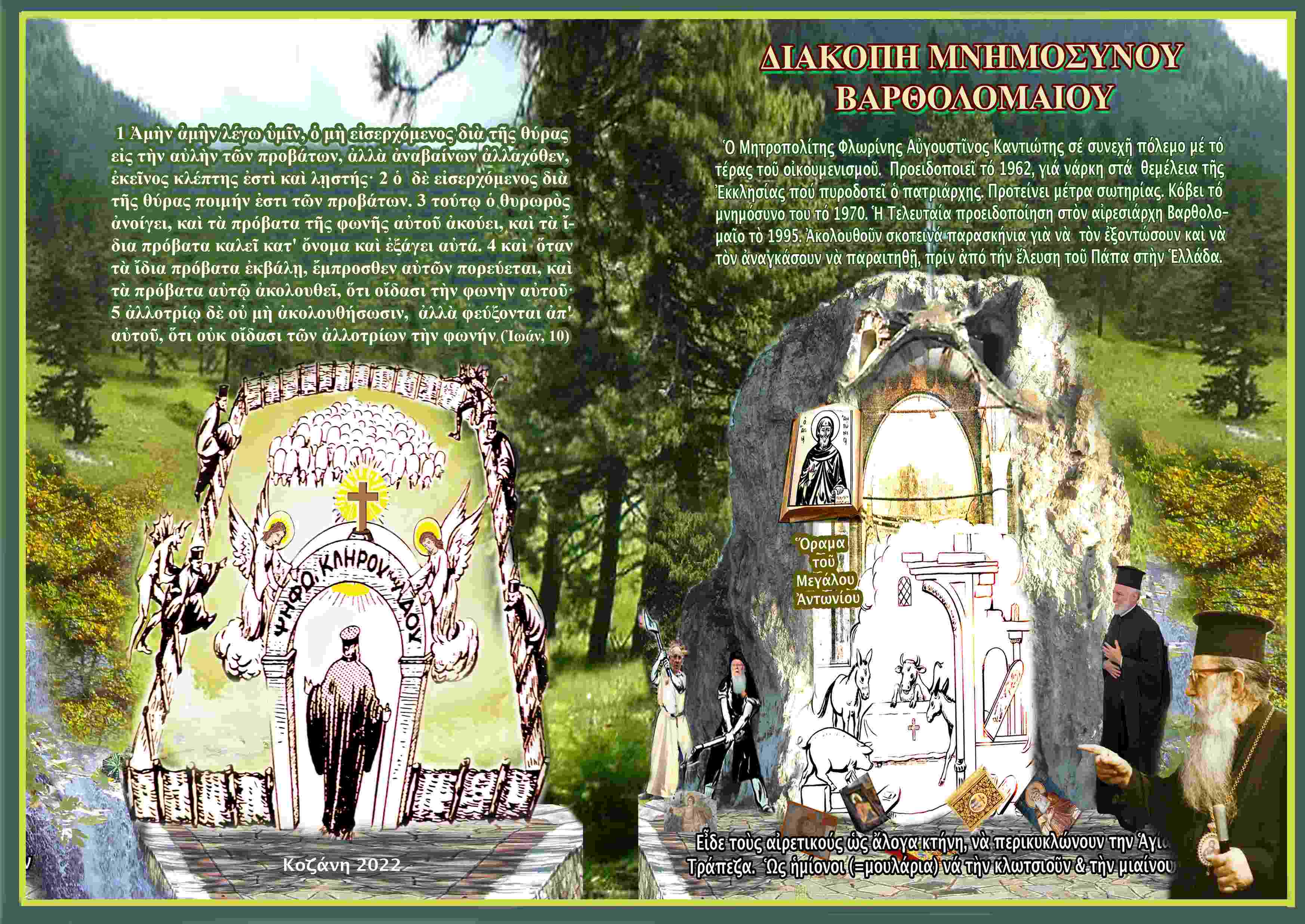THE SON OF GOD
 Απρ 11th, 2010 |
Απρ 11th, 2010 |  Filed under: English
Filed under: English
«Είς τήν Θείαν Λειτουργίαν, Πρακτικαι Ομιλίαι»!
Ομιλία 7 – Ο ΥΙΟΣ ΤΟΥ ΘΕΟΥ
Η μετάφρασι ολόκληρου τού βιβλίου (δύο τόμους) στά Αγγλλικά έγινε από τόν ακούραστο εργάτη καί αγωνιστή της Ορθοδοξίας, πνευματικόν τέκνον του πατρός Αυγουστίνου, πατέρα Αστέριο Γεροστέργιο. Προσφέρεται ταπεινά καί μέ τήν έν Χριστώ αγάπη είς ψυχικήν ωφέλειαν Ορθοδόξων Χριστιανών απνανταχού τής γής καί επισκεπτών της ιστοσελίδας τού σεβαστού Γέροντος Αυγουστίνου
πρός δόξαν του Τριαδικού μας Θεού.
THE SON OF GOD
(Ο ΥΙΟΣ ΤΟΥ ΘΕΟΥ)
 In our last homily, we saw what the names, LORD, Jesus, and Christ mean. In addition to these three names, the second article of the Symbol of Faith adds yet another name when it speaks about Christ. The name is SON OF GOD.
In our last homily, we saw what the names, LORD, Jesus, and Christ mean. In addition to these three names, the second article of the Symbol of Faith adds yet another name when it speaks about Christ. The name is SON OF GOD.
Christ is the Son of God. About this we will now speak. The subject is very difficult, but very necessary for our salvation. Let us invoke the Holy Spirit to enlighten us to sense and understand the truth contained in these few words.
Once, when Christ was alone with His disciples in a desolate place, He asked them a question: “Who do men say that I, the Son of man, am?” (Matt.16:13). That is to say, when people hear my teaching and see my miracles, what is their opinion of me? The disciples answered: Some say you are John the Baptist; others that you are Elijah the Prophet; others, that you are Jeremiah; and still others, that you are one of the prophets of the Old Testament returned from the dead.
As we can see from the disciples answers expressing the impression Christ gave to those who saw Him, everybody except His bitter enemies admired Him and considered Him an excellent person, a great personality, who, by what He said and did, was able to emulate historic persons of the Old Testament. But they thought no further. And this is still happening today. People of our times, like the ancient Jews, admire Christ as a great man in world history, but they stop there.
After this answer, Christ asked a second question: “Who do you say that I am?” (Matt.16:16). That is, people who hear me have this notion about me, thinking that I am one of the prophets, but you, who live with me, what do you think about me?
Peter, who was the most ardent of the disciples, answered the question: “Thou art Christ, the Son of the living God”. Upon hearing Peter’s confession, Christ said: Blessed are thou, Simon Bar-jona: for flesh and blood hath not revealed it unto thee, but my Father which is in heaven.” He enlightened your mind and you said it. This is a truth. And on this truth, like on a firm, unshakable rock, I will build a Church, and no power of satan will ever be able to destroy it.
What Peter confessed in that desolate place the Church is still preaching and will continue to preach until the end of time.
O my Christ! Your are the Son of God, living and reigning forever.
When Christ was arrested and brought before the Jewish Court and the High Priest asked Him, “Art thou the Son of the living God?” if Christ answered “no” to this question, the accusations would have been dissolved and Christ would not have been condemned to death; but Christ answered with a firm and unshakable “yes”, because his answer “Thou hast said” means “Yes”. The High Priest understood it to mean “yes” and that is why, when he heard he was horrified, tore his clothes, and said that Christ had blasphemed because He made himself out to be the Son of God, adding “We do not have further need of witnesses” (Matt 22:63-65).
Now the question is put to us: What did Christ mean when He said He was the Son of the living God, for even we are called sons of God and raise our eye to heaven and call God “Father”. We are children of God, but Christ’s name of Son of God differs greatly from our being called sons of God. Christ is not the Son of God by calling, but by nature. He is of the same essence, consubstantial. He is not a creation, like us. We are of a different essence, a different substance.
Are the things we discuss too difficult? Let’s try to simplify them.
Our existence in this world is limited. There was a time when we did not exist. We were born and came into the world at a certain point in time. We live in the world for a few year until the time comes to die, and we end our bodily life. Our soul does not die, it’s immortal; however, we are speaking about bodily existence. While we live but a short time, Christ, as Son of the living God, was born in a way beyond our understanding, before all ages, before Abraham and Noah, before Adam, before the creation of the angles and archangels. There was not a moment in all of time when Christ did not exist, and to use theological language, we say, “As the Father exists, so exists the Son and the Holy Spirit: O Holy Trinity, glory to Thee!”
It is in this sense, which we in some way explained, that the Holy Scriptures refer to Christ as the Son of God, and this is declared as a truth of the Faith in the Symbol of the Faith.
Unfortunately, a man named Arius did not accept this fundamental truth of our Church. He admired Christ as a man, preached His grandeur, confessed His miracles but did not accept Him as God. He maintained that Christ is the first creation, superior to the angels and archangels, but lower than God. He preached that there was a time when Christ did not exist. This is the horrible heresy of Arius, and it is this heresy that the Jehovah’s witnesses teach today, and they blaspheme St.Athanasios the Great while honoring the arch-heretic Arius.
The heresy that Christ is not True God, but a creation of God, was condemned by the First Ecumenical Synod. The Synod declared Christ to be consubstantial with (of the same essence as) the Father. The followers of Arius fiercely fought against this “consubstantial”. At one point they wanted to add one letter to the Greek word for consubstantial, “homo-ousios”, “i”, iota, in order to call Christ Homoi-ousios (of similar essence) instead of homo-ousios (of the same essence).
The Church did not want to add this iota and struggled greatly, and the Symbol of the Faith remained unchanged. Together with the Saints and Confessors, let every one of us proclaim: “I believe in one Lord Jesus Christ, the only-begotten Son of God, begotten of the Father before all ages. Light of Light, True God of True God, begotten, not created, of one essence with the Father, through Whom all things were made”.
This chapter was taken from the book “ON THE DEVINE LITURGY – VOL.2” by Bishop Augoustinos N. Kantiotes.
Translation by
Rev. Fr. Asterios Gerostergios
e-mail: ibmgs3@verizon.net
www.orthodoxinfo.com/ibmgs
Απόσπασμα από τό βιβλίο του Μητροπολίτου Φλωρίνης πατρός Αυγουστίνου Καντιώτου
«Είς τήν Θείαν Λειτουργίαν, Πρακτικαι Ομιλίαι»!
Ομιλία 8
Ο ΥΙΟΣ ΤΟΥ ΑΝΘΡΩΠΟΥ
THE SON OF MAN
“Who for us and for our salvation came down from Heaven,
and was incarnated by the Holy Spirit and of the Virgin Mary…”
 Our Lord is a sign that has been contradicted. People have made war over his name. This began on the day of His birth and continues to this day, and will go on until the end of the world. No other person in history was fought over so much as Christ. Unbelievers and atheists reject Him; heretics teach ideas which are contrary to the Holy Scriptures and our Sacred Tradition. Heretics, egotists that they are, interpret the Holy Scripture as they wish and think they have discovered something new. Some of them dispute the divinity of Christ, others question the humanity of Christ. Who are they?
Our Lord is a sign that has been contradicted. People have made war over his name. This began on the day of His birth and continues to this day, and will go on until the end of the world. No other person in history was fought over so much as Christ. Unbelievers and atheists reject Him; heretics teach ideas which are contrary to the Holy Scriptures and our Sacred Tradition. Heretics, egotists that they are, interpret the Holy Scripture as they wish and think they have discovered something new. Some of them dispute the divinity of Christ, others question the humanity of Christ. Who are they?
They are the heretics who, on one hand accept that Christ is God, but on the other, do not admit that Christ became a man like us. They reject Christ’s human nature. They maintain that the body with which Christ appeared on earth was not real, but an imaginary one. They think they are elevating Christ in this way, saying He did not have any relationship with human flesh. They consider it degrading to say that Christ took on human flesh and became a real human being.
The heretics who rejected Christ’s divinity were the Arians, the ones who rejected Christ’s humanity were called Docetists. The Church however fought both Docetism and Arianism. St. John the Evangelist says, concerning those who reject the truth that Christ took on human flesh, that they have the spirit of Antichrist (II John 7).
Christ, who called Himself the Son of God, also referred to Himself as the Son of Man. Eighty times in the New Testament, Christ is called the Son of Man; and He is called so to emphasize that, besides having a Divine Nature, Christ also has Human Nature, which came with His birth from the Virgin Mary. He was made flesh and dwelt among us (John 1:14).
Christ is perfect God, but perfect man as well. The Gospels, which describe the details of His earthly life, show that He was a true man, similar to us, and not a ghost or a phantom like those seen in dreams. As we can see in the sacred texts, Christ became hungry and thirsty, felt pain, cried and felt the need of rest and sleep – He slept on the deck of a ship and under the shade of trees; His immaculate hands and feet were pierced by nails, His side by a soldier’s lance, and blood and water came out (John 19:34).
These things were written by eye-witnesses, the Evangelists. They are not fantasies, but real events. Over and over again, Christ, speaking about the time of His suffering, refers to Himself as “Son of Man”. When asked where He lived, that he might be visited, Christ answered that even the wild beasts have their nests, but the Son of Man hath not where to put His head (Matt.8:20). Christ lived like the very poor, and tasted the sorrows and sufferings of human nature. He did not live outside the world, but in the midst of it with its suffering people, felt their pains and sorrows, and the “Son of Man” cried with them.
Christ is perfect man and perfect God. This is the teaching of our Church, a teaching which is not arbitrary but based on the Holy Scriptures. And whoever questions the divinity or humanity of Christ is outside both the letter and spirit of the word of God.
But unbelieving heretics, upon hearing this teaching about Christ, are scandalized and ask: “How is it possible to unite the divine and human natures?” We reply that the union of the divine and human nature in the Person of Christ is truly a great mystery. As Apostle Paul says “And without controversy great is the mystery of godliness: God was manifested in the flesh, justified in the Spirit, seen of angles, preached unto the Gentiles, believed on in the world, received up into glory” (I Tim.3:16).
An example will give us some faint image of this mystery. We say that the two natures were united in Christ “unconfused, unaltered, unchanged, and indivisible”, but let us briefly look into every man and we will see the union of two dissimilar things. One is the body, the other is the soul. The first is perishable, the second imperishable; one is visible and the other invisible; one natural the other supernatural; one is material, the other immaterial. In spite of this, however, these are united in man. How? It is a mystery! Therefore, as these are united I man, in a similar manner the two natures, divine and human were united in Christ.
Yes, Christ is a perfect man. But how? Wasn’t there a perfect man before Christ? Our answer: the first man, Adam, was created without sin. He was created with wonderful psychic powers, which, when used rightly would have given him continuous progress towards perfection and he would have become like God. But as we all know, the first man, Adam, did not remain in the state in which God placed him. He sinned. He made bad use of his divine gifts, and instead of being elevated, he fell. All men, who came from Adam, became corrupt, and their wickedness and bad habits, their crimes, impiety and unbelief began to conceal that beautiful image in man. They cried and moaned for their corruption and felt the need of someone from heaven to restore the image, to save mankind.
The one for whom men and nations were waiting appeared. He is Christ. He is the New Man, the New Adam, the Son of Man. Christ, with His virtues, appeared in the world, becoming the image – and not just an image, but the original image, namely the unique, excellent example of virtue, for people to look to and imitate.
With Christ as a prototype, people again become truly human, with all the depth and breadth the word contains, while outside of Christ, man is dehumanized, losing every element of nobility, exhibiting not the image of Christ but that of Antichrist.
This chapter was taken from the book “ON THE DEVINE LITURGY – VOL.2” by Bishop Augoustinos N. Kantiotes.
Translation by
Rev. Fr. Asterios Gerostergios
e-mail: ibmgs3@verizon.net
www.orthodoxinfo.com/ibmgs
Απόσπασμα από τό βιβλίο του πατρός Αυγουστίνου
«Είς τήν Θείαν Λειτουργίαν, Πρακτικαι Ομιλίαι»!
Ομιλία 9
THE ALL HOLY VIRGIN
Η ΠΑΡΘΕΝΟΣ
“An was incarnated by the Holy Spirit and of the Virgin Mary and became man”
 Dear friends, humanity is the summit of earthly creation, and if God created nothing else, mankind would be enough to testify that there is a God, an all-wise God, omnipotent and benevolent. What an excellent creation man is! We see a beautiful statue and admire it, and no one dares to say the statue created itself without the sculptor. But, when compared to a human, what is a statue, even the most perfect one kept in a museum and considered a treasure of infinitive value? The statue is dead, inanimate, idle. It has eyes but does not see, ears but does not hear, feet but cannot walk. Man, however, is alive, with soul, and active and creative statue, which when studied more and more gains more and more admiration. Common sense says that, just as every statue was made by an artist, man was created by God.
Dear friends, humanity is the summit of earthly creation, and if God created nothing else, mankind would be enough to testify that there is a God, an all-wise God, omnipotent and benevolent. What an excellent creation man is! We see a beautiful statue and admire it, and no one dares to say the statue created itself without the sculptor. But, when compared to a human, what is a statue, even the most perfect one kept in a museum and considered a treasure of infinitive value? The statue is dead, inanimate, idle. It has eyes but does not see, ears but does not hear, feet but cannot walk. Man, however, is alive, with soul, and active and creative statue, which when studied more and more gains more and more admiration. Common sense says that, just as every statue was made by an artist, man was created by God.
Man is a marvelous creation of God, a little bit less than the angels, and is divided into man and woman. Man and woman are equal. They have the basic characteristics of human personality, reason, conscience, will and the rest. They do possess differences, but the differences between man and woman does not reduce, but rather enhance the admiration due to humanity. They add beauty and charm, making human life a pleasant thing. Since the first man until now, billions of people have been born. Of these billions of people, men and women, there have been some who have tried to destroy the grandeur of humanity by their criminal acts, they tried to degrade the human personality and put the human race to shame. Mankind fell from the lofty height of honor and dignity into the slime of dishonorable passions, and became like the wild beasts. Reading history and seeing contemporary reality, one shudders and is ashamed of mankind’s horrible crimes and shameful acts. Among billions of people, however, there are still some who, by their acts and virtues, have honored and continue to honor humanity, demonstrating that we were created for a higher purpose, making us aspire for heaven, for the blessed life which man lived in Paradise before the Fall.
If someone should ask which human being of all the billions of human beings who have lived on earth reached the highest point of moral grandeur, in other words, who is the greatest of all Saints, we would answer not on our own authority, but would give the answer to the Church, which is the pillar and ground of the truth (II Tim.3:15). Our Church, having the Holy Scriptures as a foundation, answers that, after Christ, who is not a mere man, but the God-Man and a Saint in the absolute sense, comes a woman. She is the All-Holy Virgin Mary.
The Virgin Mary, by God’s grace and through her virtues, came to such a high state of holiness that she surpassed not only every human being, but even the angels and the archangels. The spiritual height and depth of the Virgin, to use the word of the Akathist Hymn, are unattainable: “Hail Height insurmountable for the human mind; Hail Depth inexplorable to angelic eye.”
The Virgin, as our Church praises her, is ‘more honorable than the Cherubim and incomparably more glorious than the Seraphim’. If mankind is a miracle of divine creation then the Virgin Mary is the most exceptional miracle of divine grace.
From the moment when the first woman, Eve, sinned and carried mankind along with her into the abyss of calamity, centuries and millennia had passed. In the midst of this terrible darkness, one hope warmed souls, namely, that the situation would one day be radically different. The ancient prophecy, the first prophecy after the Fall of the First Man and First Woman, the First Gospel as it was called, spoke about a woman, a woman whose son would fight and defeat satan, and would give the world new life. From careful study of this prophecy, it is apparent that this woman would not give birth in the usual way women give birth. This woman would give birth without knowing man. She would bear as a virgin. This prophecy about the virgin is repeated more precisely and with different symbols in the Old Testament. The Book of Isaiah gives the clearest prophecy: “Behold, a virgin shall conceive in the womb, and shall bring forth a son, and his name shall be called Emmanuel” (Isaiah 7:14). Eight hundred years before the star of Bethlehem shone, Isaiah saw the Virgin and her son Emmanuel.
The Virgin gave birth to her only-begotten son, our Lord Jesus Christ. But how did the Virgin give birth? Unbelievers of every century have argued against this and will continue to do so. What do we answer? We say: “which is a greater miracle – a Virgin to give birth or the world to be created from nothing?” Certainly, the greater is the creation of the universe from nothing, and if this greater one took place, why not a lesser miracle, the Virgin Birth?
The all-holy Mother of God was a virgin before giving birth, during birth, and remained a virgin after giving birth. Our holy Lady is ever-virgin. Our Church preaches this as a revealed truth, and we proclaim this truth each time we recite the Symbol of Faith, saying: “and was incarnated by the Holy Spirit and of the Virgin Mary, and became man.”
We Orthodox do not deify the Virgin, as some heretics like Protestants and Jehovah’s Witnesses accuse us. We do not believe that the Virgin is a Goddess, but we say that the Virgin is superior to the angels, and that is why we call her Most Holy – that God selected the Most holy Mother in order to take flesh and be born. For this reason we call her Theotokos, God-birthgiver. Because of her exceptional virtues she is the perfect example of Woman.
But while the Holy Scripture and the Church in its teaching elevate the Virgin to ineffable heights, and angels and archangels bow before her, we have in our own country many nominal Christians who open their foul mouths and blaspheme her worse than heretics and unbelievers!
Dear Christians, let us all fight to stop this blasphemy and save ourselves from God’s wrath.
This chapter was taken from the book “ON THE DEVINE LITURGY – VOL.2” by Bishop Augoustinos N. Kantiotes.
Translation by
Rev. Fr. Asterios Gerostergios
e-mail: ibmgs3@verizon.net
www.orthodoxinfo.com/ibmgs



Add A Comment
You must be logged in to post a comment.